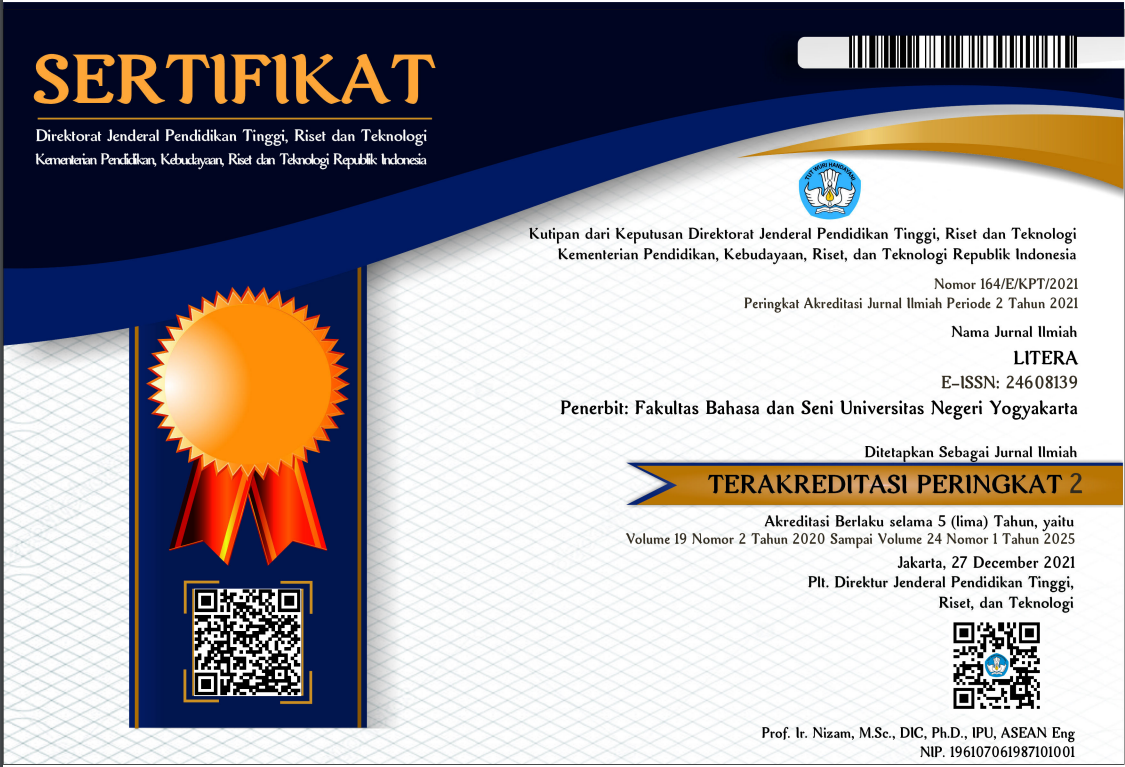Contesting Alinesitoué Diatta: The polyphony of prophetic discourses in Boubacar Boris Diop's Les tambours de la mémoire
Downloads
Alinesitoué Diatta is a prophetess within the Awasena religion, an indigenous religion from Casamance, Senegal. However, nowadays, her prophetic identity is less known than her image as a national hero, specifically as a Senegalese freedom fighter. This article examines the representation of Alinesitoué Diatta through the character Johanna Simentho in Boubacar Boris Diop's novel Les Tambours de la Mémoire (1987). It aims to explore whether the novel revives the prophetic narrative of Alinesitoué Diatta or merely continues her political image constructed by the Senegalese government. Moreover, this article analyzes the relation between the character's representation and the narrative contestation about her that occurred in Senegal during 1980s. This research uses Mikhaí¯l Bakhtin's polyphony theory, Stephen Greenblatt's new historicism, and Max Weber's prophetic theory to examine these topics. Employing a descriptive qualitative method, we collected primary data consisting of novel quotations about the character Johanna Simentho and compared them with Alinesitoué Diatta's historical narrative. This research found that the use of polyphonic narratives in the novel represents the narrative contestation over Alinesitoué Diatta by the Senegalese government, FCS, and Kabrousse villagers. Furthermore, the article also found that the novel has revived Alinesitoué Diatta's prophetic narrative even though this prophetic representation intertwines with a masculine narrative depicting her as "Yo jigeen ci mun goor" or "a woman who is stronger than men".
Downloads
Althusser, Louis. (2001). Lenin and Philosophy and Other Essays (Ben Brewster, Trans.). New York: Monthly Review Press.
Amnesty International. (1997, January 1). Amnesty International Report 1997"”Senegal. Retrieved from Refworld: https://www.refworld.org/reference/annualreport/amnesty/1997/en/91263
Bakhtine, M. (1970). La Poétique de Dostoí¯evski. Paris: Seuil Publishing.
Balandier, G. (1953). Messianismes et Nationalismes en Afrique Noire. Cahiers Internationaux de Sociologie, 14, 41–65. https://www.jstor.org/stable/40688841
Baum, R. M. (2016). West Africa's Women of God: Alinesitoué and the Diola Prophetic Tradition. Indiana University Press. https://www.jstor.org/stable/j.ctt17t7571
Baum, Robert, M. & Waldman, M. R. (1992). Innovation in Religions Traditions: The "Prophet" as an Agent of Change, dans Innovation in Religions Traditions. Boston: de Gruyter.
BBC News Afrique. (2012, September 25). Aline Sitoé Daitta succède au Joola. Retrieved from BBC News Afrique: https://www.bbc.com/afrique/region/2012/09/120925_jool_aline
Diop, B. B. (1990). Les Tambours de la Memoire (Vol. 76). Senegal: L'harmattam publishing.
Diop, P. S. (2018). Introduction í l'oeuvre littéraire de Boubacar Boris Diop: Du franí§ais au wolof. 46, 19–29. https://doi.org/10.7202/1062264ar
Dongala, E. (2018). La Feu des Origines (Vol. 33). Arles: Actes Sud publishing.
Dozon, J. P. (2008). La Cause de prophètes, politique et religion en Afrique contemporaine. Paris: Seuil Publishing.
Fall, Marouba. (2005). Aliin Sitooye Jaata, ou, La dame de Kabrus: Suivi de Adja, militante du G.R.A.S. (2nd ed.). Nouvelles éditions africaines du Sénégal.
Foucher, V. (2019). The Mouvement des Forces Démocratiques de Casamance: The Illusion of Separatism in Senegal?: Aspiration, Grievance, Performance, Disenchantment (pp. 265–292). Palgrave Macmillan, Cham. https://doi.org/10.1007/978-3-319-90206-7_10
Gallagher, C. & Greenblatt, S. (2001). Practicing New Historism. University of Chicago Press.
Genette, G. (1972). Figures III. Paris: Seuil Publishing.
Gierczynski-Bocandé, U. (2013). Women in Senegal's Politics and Society: Priestesses, Princesses, Presidents? (WOMEN IN POLITICS AND SOCIETY, pp. 24–47). Konrad Adenauer Stiftung. https://www.jstor.org/stable/resrep10122.5
Girard, Jean. (2012, January 23). Genèse du pouvoir charismatique en basse Casamance (Sénégal). Retrieved from Cambridge Core: https://www.cambridge.org/core/journals/africa/article/abs/genese-du-pouvoir-charismatique-en-basse-casamance-senegal-by-jean-girard-dakar-inst-fondamental-dafrique-noire-ifan-1969-initiations-et-etudes-africaines-27-pp-372-bibl-ill-maps/2969089DFA652DDCDD33EB08D7C8F50D
Godin, J. C. (2018). Nouvelles écritures francophones. : Presses de l'Université de Montréal.
Greenblatt, S. (2005). Renaissance Self-Fashioning: From More to Shakespeare. University of Chicago Press.
Kadari, L., Leroux, P., & Shango, T. (2015). Prophétismes ou discours de l'entre-deux voix. Francophonies africaines. Presses de la Sorbonne Nouvelle.
Kane, O., & Kane, H. (2018). The origins of the feminist movement in Senegal: A social history of the pioneering Yewwu-Yewwi. African Sociological Review / Revue Africaine de Sociologie, 22(1), 18–30. https://www.jstor.org/stable/90023844
Lukacs, G. (1962). The Historican Novel (1st ed.). London: The Merlin Press.
Morris, A. (2018, July). Boubacar Boris Diop: Interview. Retrieved from: TriQuarterly: https://www.triquarterly.org/the-latest-word/interviews/boubacar-boris-diop-interview
Ndiaye, C. (2001). De l'authenticité des mensonges chez Boubacar Boris Diop. In J. C. Godin (Ed.), Nouvelles écritures francophones: Vers un nouveau baroque ? (pp. 319–337). Presses de l'Université de Montréal. https://doi.org/10.4000/books.pum.9620
Ndiaye, C. (2019). Monstres, princesses et justicières: Du féminin pluriel chez Boubacar Boris Diop. í‰tudes franí§aises, 55(3), 57–72. https://doi.org/10.7202/1066606ar
Neher, A. (2004). , Prophètes et prophétisme: L'essence du prophétisme. Paris: Payot Publishing.
Nissim, L. (2009). "Ne pas écrire couché": Boubacar Boris Diop, l'écrivain tourné vers l'avenir. Altre Modernití , 2, Article 2. https://doi.org/10.13130/2035-7680/293
Panuntun, Ari, B. (2024, August 17). Kekuasaan dan Kenabian. Retrieved from IndoPROGRESS: https://indoprogress.com/2024/08/kekuasaan-dan-kenabian/
Petrarca, Valerio. (2012). Prophètes d'Afrique noire au XXe siècle dans Prophètes et prophétisme. Paris: Seuil Publishing.
Pivin, J. & Foadey, G. (1992, September). Revue Noire"”Music. 07, 34.
Sarr, F. (2011). Histoire, fiction et mémoire dans l'Å“uvre de Boubacar Boris Diop. Université de Montreal. https://papyrus.bib.umontreal.ca/xmlui/handle/1866/5491
Seck, W. B. (Director). (2018). Wally B. Seck"”Baye Fallou. Retrieved from youtube: https://www.youtube.com/watch?v=pr1ytoliocQ
Sokro, N.-A. (1979). Remarques sur le prophétisme et le messianisme africains. https://doi.org/10.3406/rhpr.1979.4497
Sousou & Maher Cissoko (Director). (2016). Sousou & Maher Cissoko: Aline Sitoe Diatta (Official Video) Retrieved from youtube: https://www.youtube.com/watch?v=bII8XqGjLQ4
Toliver-Diallo, W. J. (2005). "The Woman Who Was More than a Man": Making Aline Sitoe Diatta into a National Heroine in Senegal. Canadian Journal of African Studies / Revue Canadienne Des í‰tudes Africaines, 39(2), 338–360. http://www.jstor.org/stable/25067487
Vauchez, A. (2012). Prophètes et prophétisme. Paris: Seuil Publishing.
Veeser, H. A. (1989). The New Historicism (1st ed.). London: Routledge Publishing.
Weber, M. (2013). Sociologie de la religion: í‰conomie et société. Paris: Flammarion Publishing.
Xalima News. (2018, February 15). Entretien exclusif avec Boubacar Boris Diop: Le processus déculturation n'est pas achevé au Sénégal. Retrieved from Xalima News: https://www.xalimasn.com/entretien-exclusif-avec-boubacar-boris-diop-le-processus-deculturation-nest-pas-acheve-au-senegal/
























